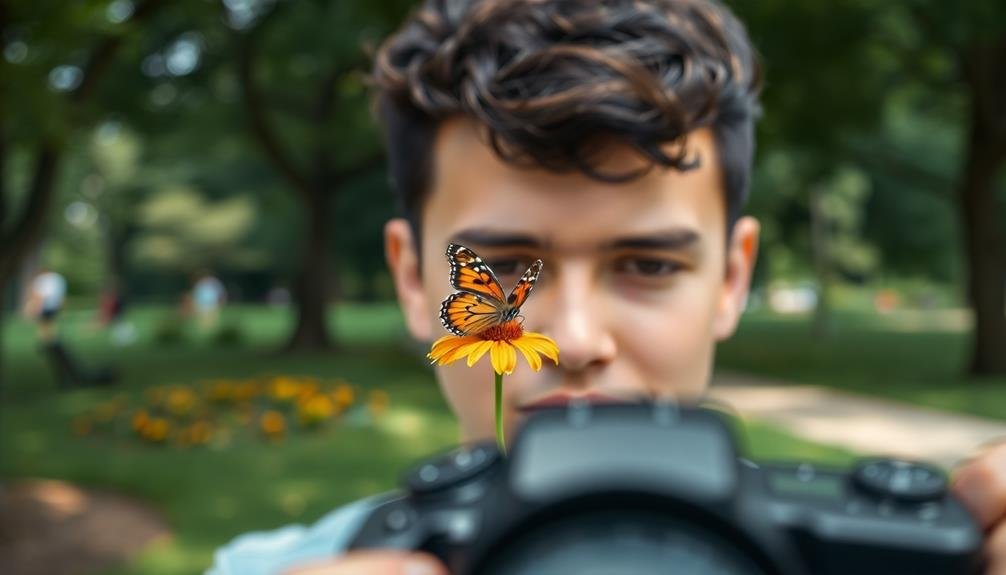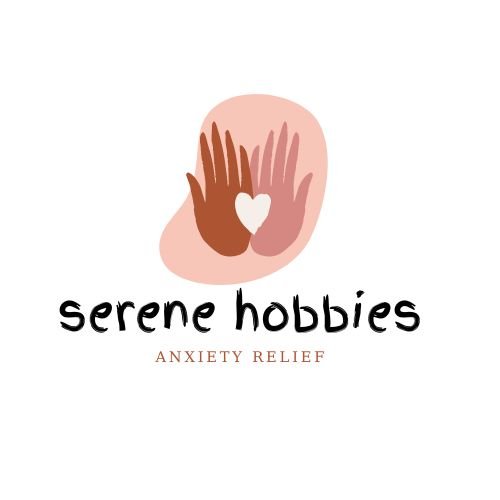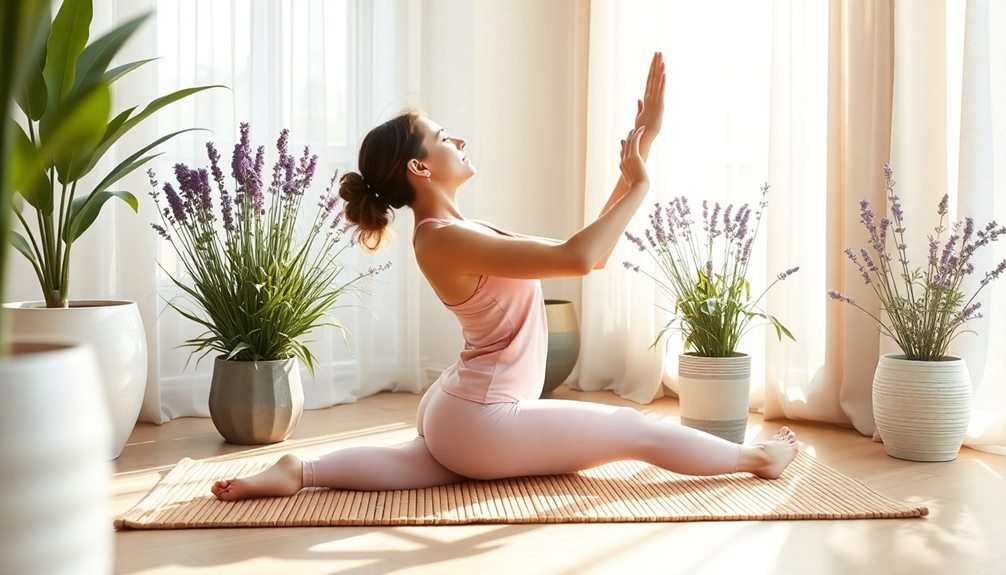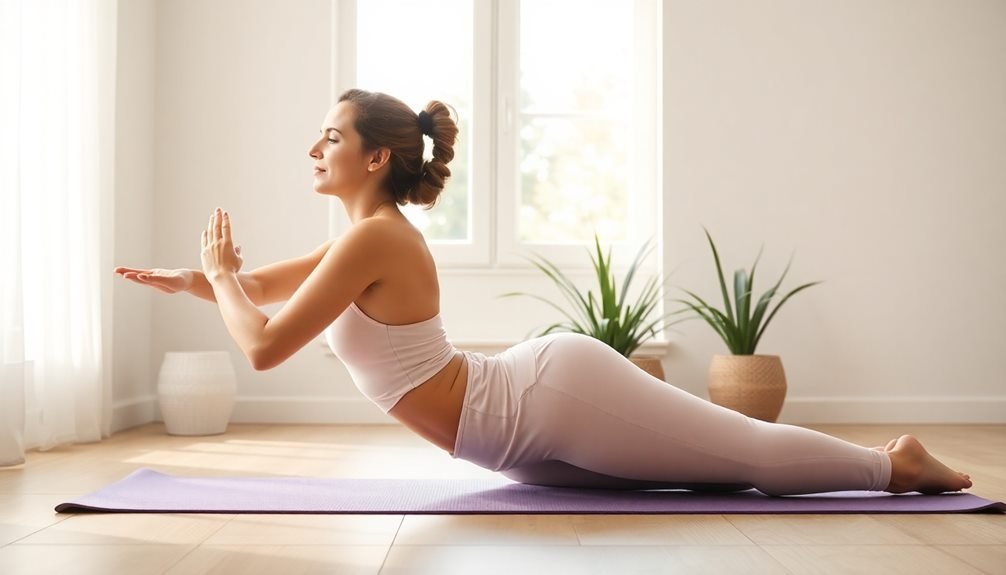Therapeutic photo scavenger hunts soothe anxious minds by blending creativity, mindfulness, and social connection. You'll engage in present-moment awareness through photography, shifting your focus from internal worries to external stimuli. This practice encourages close observation and creativity, fostering a state of flow that reduces mental clutter. As you collaborate with others, you'll build social bonds and share experiences, combating feelings of isolation. The act of capturing images serves as a powerful outlet for processing complex emotions, providing tangible records of your internal landscape. By exploring this unique form of therapy, you'll discover a multifaceted approach to anxiety relief and self-expression.
Understanding Therapeutic Photo Scavenger Hunts

Therapeutic photo scavenger hunts blend creativity, mindfulness, and exploration to promote mental well-being. You'll find these activities designed to engage your senses and shift your focus away from anxious thoughts. They typically involve a list of specific items or themes to photograph within a set timeframe, encouraging you to observe your surroundings more closely.
Unlike traditional scavenger hunts, the emphasis isn't on competition but on the process of discovery and self-expression. You're not just searching for objects; you're capturing moments, emotions, and perspectives through your lens. This practice combines elements of art therapy and mindfulness meditation, allowing you to express yourself visually while staying present in the moment.
The therapeutic aspect lies in how these hunts redirect your attention from internal worries to external stimuli. You'll find yourself noticing details you might otherwise overlook, appreciating beauty in unexpected places, and experiencing a sense of accomplishment with each photo taken.
The act of framing and capturing images can be calming, giving your mind a break from rumination. Additionally, reviewing your photos afterward can provide insights into your thought patterns and perceptions, fostering self-reflection and personal growth.
Mindfulness Through Photography
One of the key elements of therapeutic photo scavenger hunts is the practice of mindfulness through photography. When you're engaged in this activity, you're forced to be present in the moment, focusing on your surroundings and the task at hand. This heightened awareness helps quiet the anxious mind, redirecting your thoughts away from worries and onto the visual world around you.
As you search for specific items or scenes to photograph, you'll find yourself paying closer attention to details you might otherwise overlook. This process encourages a state of flow, where you're fully immersed in the experience. You'll notice textures, colors, and patterns that you may have missed before, fostering a deeper connection with your environment.
The act of framing and capturing an image requires concentration and creativity, further anchoring you in the present. You'll make decisions about composition, lighting, and perspective, all of which demand your full attention.
This focused engagement can provide a much-needed respite from anxious thoughts, allowing your mind to reset and find calm in the simple act of observation and creation.
Shifting Focus From Anxiety

While mindfulness through photography helps ground you in the present, therapeutic photo scavenger hunts offer a powerful tool for shifting focus away from anxiety. These structured activities redirect your attention from internal worries to external objectives, engaging your mind in a purposeful search for specific images or scenes.
As you initiate your photo hunt, you'll find yourself actively looking for items on your list rather than dwelling on anxious thoughts. This shift in focus can be particularly beneficial during moments of heightened stress or panic. The act of searching, framing, and capturing images requires concentration, leaving less mental bandwidth for anxiety to take hold.
Moreover, the challenge of finding and photographing specific subjects can create a sense of accomplishment with each successful shot. This positive reinforcement can boost your mood and self-confidence, further diminishing anxiety's grip.
The variety of subjects in your scavenger hunt also encourages you to explore your environment more thoroughly, potentially leading to new discoveries and perspectives that can broaden your outlook beyond anxiety-inducing concerns.
Social Connection and Shared Experiences
Photo scavenger hunts offer a unique opportunity for social connection through shared goals and experiences.
You'll find yourself collaborating with others to solve clues and capture specific images, fostering teamwork and communication.
These adventures create a sense of camaraderie as you work together to overcome challenges and celebrate your collective achievements.
Bonding Through Shared Goals
Through shared goals and experiences, therapeutic photo scavenger hunts foster social connections among participants.
You'll find yourself working together with others to achieve a common objective, creating a sense of camaraderie and shared purpose. As you collaborate to find and photograph specific items or scenes, you're building trust and developing communication skills with your fellow participants.
These shared goals encourage teamwork and mutual support, as you rely on each other's strengths and perspectives to complete the hunt successfully.
You'll learn to appreciate diverse viewpoints and problem-solving approaches, enhancing your social skills and empathy.
The collective achievement of completing the scavenger hunt can boost your confidence and self-esteem, reinforcing positive social interactions.
You'll likely find yourself opening up to others more easily, sharing personal experiences and insights related to the hunt's themes.
This bonding experience can lead to lasting friendships and support networks, extending beyond the therapy session.
Collaborative Problem-Solving Adventures
Therapeutic photo scavenger hunts transform into collaborative problem-solving adventures, challenging participants to think creatively and work together. As you commence on these journeys, you'll find yourself engaging in dynamic group activities that foster teamwork and communication.
You'll face puzzles, riddles, and visual challenges that require collective effort to solve, strengthening your bonds with fellow participants.
These collaborative experiences offer numerous benefits:
- Enhanced problem-solving skills
- Improved communication and teamwork
- Increased self-confidence through shared accomplishments
- Reduced feelings of isolation and anxiety
As you navigate through the scavenger hunt, you'll discover that each team member brings unique strengths to the table. You might excel at deciphering clues, while your partner has a keen eye for spotting hidden objects.
This diversity of skills creates a supportive environment where everyone's contributions are valued.
The shared experience of overcoming obstacles and achieving goals together can be incredibly empowering. You'll find that the sense of accomplishment extends beyond the hunt itself, boosting your confidence in everyday life.
Creative Expression as Anxiety Relief

Creative expression through photography can be a powerful tool for anxiety relief.
You'll find that capturing emotions through imagery allows you to externalize and process your feelings in a tangible way.
As you focus on mindful framing and composition, you're engaging in a meditative practice that can help calm your mind and redirect anxious thoughts.
Capturing Emotions Through Imagery
Photography offers a powerful outlet for expressing complex emotions that can be difficult to put into words. When you're feeling anxious, overwhelmed, or stuck, picking up a camera can help you process and communicate your inner experiences.
Through the lens, you can capture visual representations of your emotions, creating a tangible record of your mental state.
As you commence on a therapeutic photo scavenger hunt, challenge yourself to find images that reflect your current feelings. You'll be surprised at how the world around you can mirror your internal landscape.
Here are four ways to capture emotions through imagery:
- Look for colors that match your mood
- Seek out textures that represent your emotional state
- Find objects or scenes that symbolize your thoughts
- Experiment with different angles and perspectives to convey your feelings
Mindful Framing and Composition
Framing your shots with intention can transform a simple photo walk into a powerful anxiety-relief exercise. As you compose each image, you're forced to focus on the present moment, pushing anxious thoughts aside.
Start by selecting a subject that catches your eye, then consider how you'll frame it within your viewfinder. Experiment with different angles and perspectives. Crouch low or find a high vantage point to add interest to your composition.
Use leading lines to draw the viewer's eye through the image, creating a sense of depth and movement. Try the rule of thirds, placing key elements off-center for a more dynamic shot.
Pay attention to the interplay of light and shadow, using them to highlight your subject or create mood. Don't be afraid to get close and capture details you might normally overlook.
As you practice mindful framing, you'll find yourself becoming more attuned to your surroundings and less focused on your worries. This process of careful observation and creative decision-making can be deeply calming, providing a welcome respite from anxiety's constant chatter.
Implementing Photo Hunts Into Treatment
When introducing photo scavenger hunts into therapeutic treatment, it's important to tailor the activity to your client's specific needs and goals. Consider their comfort level with photography, physical abilities, and mental health challenges.
Start with simple, achievable tasks and gradually increase complexity as your client progresses. Incorporate themes that align with therapeutic objectives, such as self-discovery, emotion regulation, or social connection. You can create customized lists or use pre-made templates, adapting them as needed.
Encourage clients to reflect on their experiences and emotions throughout the process.
To implement photo hunts effectively:
- Set clear guidelines and time frames
- Provide necessary equipment or confirm clients have access to cameras
- Offer guidance on photography techniques if needed
- Schedule regular check-ins to discuss progress and insights
After completing the hunt, review the photos together, exploring the client's thought processes and emotional responses. Use this opportunity to identify patterns, challenge negative beliefs, and reinforce positive coping strategies.
Remember to maintain a supportive, non-judgmental atmosphere throughout the activity, allowing your client to express themselves freely through their photographic choices and interpretations.
Frequently Asked Questions
Can Therapeutic Photo Scavenger Hunts Be Effective for Children With Anxiety?
Yes, therapeutic photo scavenger hunts can be effective for children with anxiety. You'll find they provide a fun, engaging way to distract anxious minds, encourage exploration, and boost self-confidence. They're also adaptable to various age groups and anxiety levels.
Are There Any Potential Risks or Drawbacks to Photo Scavenger Hunts?
You should be aware of potential risks like privacy concerns if photos are shared online. There's also a chance of overexertion or accidents while searching for items. Some participants might feel stressed if they can't complete the hunt.
How Long Should a Typical Therapeutic Photo Scavenger Hunt Session Last?
You'll typically want your therapeutic photo scavenger hunt to last 30-60 minutes. This gives you enough time to engage fully without feeling overwhelmed. Adjust the duration based on your energy levels and personal preferences.
What Equipment Is Necessary for Participating in a Photo Scavenger Hunt?
You'll need a smartphone or digital camera to capture images. Don't forget comfortable shoes for walking and a list of items to find. A bag for collecting objects and a water bottle are also helpful.
Can Therapeutic Photo Scavenger Hunts Be Conducted Virtually or Remotely?
Yes, you can conduct therapeutic photo scavenger hunts virtually or remotely. You'll need a smartphone or camera, internet access, and a video conferencing platform. You can share prompts online and participants can submit their photos digitally for group discussions.
In Summary
You've discovered a powerful tool for managing anxiety through therapeutic photo scavenger hunts. By embracing mindfulness, shifting focus, connecting with others, and expressing yourself creatively, you're taking control of your mental health. Don't hesitate to incorporate this technique into your treatment plan. Remember, it's not just about the photos you take, but the journey of self-discovery and healing you commence. Keep exploring, keep capturing, and keep growing.





Leave a Reply